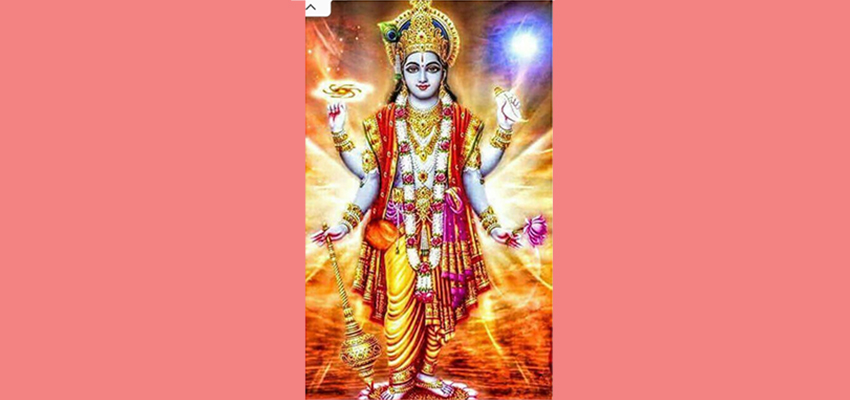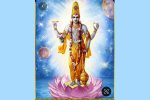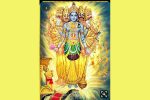NAME 11
Paramātmā परमात्मा
He is addressed as the Supreme Spirit or the Brahman. The Purest form of Consciousness is Paramātma. He is the combination of eternal existence, Pure Consciousness and Infinite Bliss. This combination is also known as sat-cit-ānanda. When Paramātma is the purest form of Consciousness, ātman (an individual soul) is His reflective image. When we talk about creation, it is nothing but His reflective images called souls that get embodied in different shapes and forms. But for this reflective image called soul, no creature can be born.
Bhagavad Gita (XIII.22) explains Paramātma, “The Spirit dwelling in this body, is really the same as the Supreme. He has been spoken as the witness, guide, sustainer, experience, the Supreme Lord and the Absolute.”
११. || ॐ परमात्माने नमः ||
11. Om Paramātmāne Namah
The Supreme, meaning that which transcends all limitations and imperfections of matter: in short, the Transcendental Reality. The Spirit is other than matter, and that in its presence, the vestures of matter, borrowing their dynamism from Him, play their parts rhythmically at all times. This has been the assertion found chorusly repeated in all the Upanishads and in the entire Vedantic literature. Sankara in AatmaBodha points out that the Self is other than the three bodies and that He functions in the microcosm as a king in the nation. It was also said therein that matter borrows its energy from the Spirit and continues its activity “as the world from the Sun”.
Kathopanishad and the Geeta guide us from the outer levels of our personality, stage by stage, into the inner-most sanctum, and there, the teachers declare, is He the Infinite, transcending all, reigning in His own glory. “In short, that which remains other than the cause and effect-Maayaa and matter-is He, the ParamaAatman. In Vishnu Purana this Supreme is glorified as Maha Vishnu (Paramaatmaa)”-Vishnu Purana 6.4.10.
The Supreme Soul – for whom there is no other guiding or superior soul.
INTERPRETATION GUIDED BY SANT VANI (WORDS OF SAINTS)
Paramātmā
The limitless.
This is a svarūpa word, a word referring to the nature of Viṣṇu. He is the ātmā, the self that is parama, free from limitations. When we look at any object in the world, let’s say a pot – it is limited. It is limited by its size. It exists in space and it occupies a definite place. It has an insignificant spatial existence. Time-wise also, it is limited. It is born in time and there will be a time when it will not be there. Since it is bound by time, it ages also, it is limited. The size of other pots also limits the pot. Thus, every object is limited in a three-fold way, that is, in terms of space, time and objects.
Parama is that which is not limited by any object, because, every object that is there, is this reality alone. There is nothing other than this limitless reality. The effect (pot) is nothing but the cause (clay). From the standpoint of the pot form, there is dependence on the clay for its existence. From the standpoint of the clay, it is independent of the pot or any other form.
Space is ātmā. Space itself is consciousness. Therefore, limitation in terms of space is not there.
Time is atma and so limitation in terms of time, is also not there. Time is consciousness, but consciousness is not time. Space is consciousness, but consciousness is not space. Object is consciousness, but consciousness is not object. Consciousness is satyam, and objects are not independent of this consciousness. All objects are only name and form. Every name and form can be further reduced to its reality, until finally what is there is only ātmā, that is, parama, free from limitations. That is the svarūpa of Parameśvara and that is the svarupa of yourself too.
Paramātmā is untouched and unaffected by anything. Again, it is both the cause and the effect.
Being the adhiṣthāna of everything, it is kārya- kāraṇa-vilakṣaṇa, free from being the cause and the effect. It is nitya-śuddha-buddha-mukta-svabhāva, ever pure, ever conscious and ever free.
The Supreme Ātmā. He who is outside the purview of the ’cause-and-effect’ relationship and therefore never ever affected by them. He is by very nature ever-free, pure, and always ‘wakeful’.
Parāsara Battar uses a nice line to describe the Parama-Ātmā (which is how he likes to split the word i.e Parama and Ātmā).
Unlike other beings who have “him” as their Ātmā, he does not have anyone as ‘his’ Ātmā and hence he is the Parama-ātmā. Therefore the following are true:
There is no one superior to him No one is superior to him The lotus-eyed one is the best of the ‘Bharatas’ and there is none greater than him in the past, present, or future How does one understand this?
The Supreme Ātmā is one but he appears to be many – not just in his multiple manifestations in the world but also by his presence in each being of the Universe as the JivaĀtmā (a spark of the divine). Just as the sky reflected in the lake, bucket, jug, pail, or glass of water appears as ‘MANY‘ but is obviously ‘ONE‘ so also the Supreme being is ‘ONE‘ – indivisible, created by none and contained within none – not even the expansive cosmos.
Therefore, despite being immanent, intrinsic, and innate within each being, he has the capacity to transcend his own creation! Even contemplating on the sheer magnificence of such a being boggles the mind…
The Supreme Ātmā. He who is outside the purview of the ’cause-and-effect’ relationship and therefore never ever affected by them. He is by very nature ever free, pure, and always ‘wakeful’.



